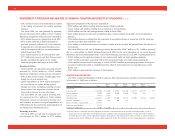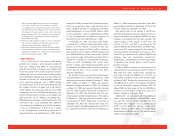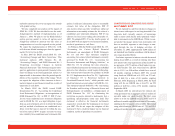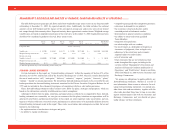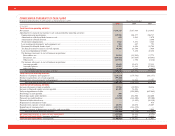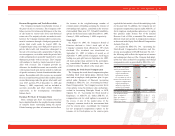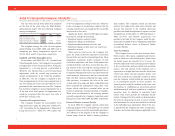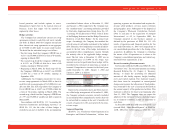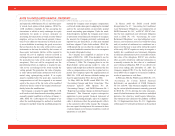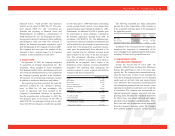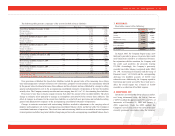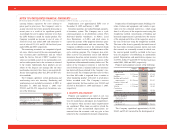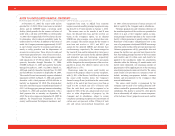Advance Auto Parts 2005 Annual Report Download - page 42
Download and view the complete annual report
Please find page 42 of the 2005 Advance Auto Parts annual report below. You can navigate through the pages in the report by either clicking on the pages listed below, or by using the keyword search tool below to find specific information within the annual report.
vendors related to cooperative advertising allowances,
volume rebates and other promotional considera-
tions. The Company accounts for vendor incentives
in accordance with Emerging Issues Task Force, or
EITF, No. 02-16, “Accounting by a Customer
(Including a Reseller) for Certain Consideration
Received from a Vendor.” Many of the incentives are
under long-term agreements (terms in excess of one
year), while others are negotiated on an annual basis.
Certain vendors require the Company to use cooper-
ative advertising allowances exclusively for advertis-
ing. The Company defines these allowances as
restricted cooperative advertising allowances and rec-
ognizes them as a reduction to selling, general and
administrative expenses as incremental advertising
expenditures are incurred. The remaining cooperative
advertising allowances not restricted by the
Company’s vendors and volume rebates are earned
based on inventory purchases and recorded as a
reduction to inventory and recognized through cost of
sales as the inventory is sold.
The Company recognizes other promotional incen-
tives earned under long-term agreements as a reduc-
tion to cost of sales. These incentives are recognized
based on the cumulative net purchases as a percent-
age of total estimated net purchases over the life of
the agreement. The Company’s margins could be
impacted positively or negatively if actual purchases
or results from any one year differ from its estimates;
however, the impact over the life of the agreement
would be the same. Short-term incentives (terms less
than one year) are recognized as a reduction to cost of
sales over the course of the agreements.
Amounts received or receivable from vendors that
are not yet earned are reflected as deferred revenue in
the accompanying consolidated balance sheets.
Management’s estimate of the portion of deferred
revenue that will be realized within one year of the
balance sheet date has been included in other current
liabilities in the accompanying consolidated balance
sheets. Total deferred revenue is $12,529 and $17,000
at December 31, 2005 and January 1, 2005, respec-
tively. Earned amounts that are receivable from
vendors are included in receivables, net on the
accompanying consolidated balance sheets, except
for that portion expected to be received after one
year, which is included in other assets, net on the
accompanying consolidated balance sheets.
Preopening Expenses
Preopening expenses, which consist primarily of
payroll and occupancy costs, are expensed as incurred.
Advertising Costs
The Company expenses advertising costs as
incurred in accordance with the American Institute of
Certified Public Accountant’s Statement of Position,
or SOP, 93-7, “Reporting on Advertising Costs.”
Gross advertising expense incurred was approxi-
mately $95,702, $86,821 and $75,870 in fiscal 2005,
2004 and 2003, respectively.
Merger and Integration Costs
As a result of the acquisition of Discount Auto Parts
(“Discount”) in 2001, the Company incurred costs
related to, among other things, overlapping administra-
tive functions and store conversions, all of which have
been expensed as incurred. These costs are presented
as expenses associated with the merger and integration
in the accompanying statements of operations.
For the fiscal year ended January 3, 2004, the
Company incurred $10,417 of merger and integration
and merger-related restructuring expenses and none
for the years ended December 31, 2005 and January 1,
2005, respectively.
Sales Returns and Allowances
The Company’s accounting policy for sales returns
and allowances consists of establishing reserves for
anticipated returns at the time of sale. The Company
anticipated returns based on current sales levels and
the Company’s historical return experience on a spe-
cific product basis.
Warranty Costs
The Company’s vendors are primarily responsible
for warranty claims. Warranty costs relating to mer-
chandise (primarily batteries) and services sold under
warranty, which are not covered by vendors’ war-
ranties, are estimated based on the Company’s histor-
ical experience and are recorded in the period the
product is sold. The Company has applied the disclo-
sure requirements of Financial Accounting Standards
Board, or FASB, Interpretation No. 45, “Guarantor’s
Accounting and Disclosure Requirements for
Guarantees, Including the Indirect Guarantees of
Indebtedness of Others,” as they relate to warranties.
The following table presents changes in our defective
and warranty reserves:
December 31, January 1, January 3,
2005 2005 2004
Defective and warranty
reserve, beginning
of period....................... $ 10,960 $ 15,578 $ 15,620
Reserves established......... 14,268 13,071 13,755
Reserves utilized(1) ............ (13,876) (17,689) (13,797)
Defective and warranty
reserve, end of period .. $ 11,352 $ 10,960 $ 15,578
(1) Reserves at the beginning of fiscal 2004 included $1,656 of
reserves established for the transition of the discontinued
operations of the wholesale dealer network. Substantially all
these reserves were utilized during fiscal 2004.
40
NOTES TO CONSOLIDATED FINANCIAL STATEMENTS
(continued)
For the Years Ended December 31, 2005, January 1, 2005 and January 3, 2004 (in thousands, except per share data)


